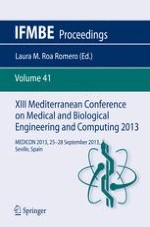2014 | OriginalPaper | Buchkapitel
Image Segmentation for Treatment Planning of Electroporation-Based Treatments of Tumors
verfasst von : M. Marcan, D. Pavliha, R. Magjarevic, D. Miklavcic
Erschienen in: XIII Mediterranean Conference on Medical and Biological Engineering and Computing 2013
Aktivieren Sie unsere intelligente Suche, um passende Fachinhalte oder Patente zu finden.
Wählen Sie Textabschnitte aus um mit Künstlicher Intelligenz passenden Patente zu finden. powered by
Markieren Sie Textabschnitte, um KI-gestützt weitere passende Inhalte zu finden. powered by
Electroporation is a term describing an increase of cell membrane permeability due to exposure of a cell to a sufficiently high electric field. The described effect is used in treatment of tumors, whether in combination with chemotherapeutic drugs (electrochemotherapy) or as a non-thermal ablation method (non-thermal irreversible electroporation). In order for the treatment to be successful it is necessary to achieve complete coverage of the tumor volume by a sufficiently high electric field. In cases of applying electroporation-based treatments on deep-seated solid tumors the complete tumor coverage is predicted through treatment planning. In the core of treatment planning are numerical calculations based on real patient geometry acquired through segmentation of medical images.
Our aim is to create an integrated treatment planning procedure to be used for electroporation-based treatments. The procedure includes image segmentation methods for images of various modalities and imaging parameters. Therefore, we aim towards creating image segmentation methods that would be as robust as possible with least user interaction. Our first task was performing image segmentation in order to facilitate treatment planning for electrochemotherapy of colorectal metastases in the liver. The aim was to segment hepatic vessels with a diameter size > 3 mm which should not be damaged during insertion of electrodes. We implemented two methods: the first based on region growing and the second combining multi-scale filtering with automatic thresholding. We also performed the validation of implemented methods on phantoms regarding the sizes of objects which are of interest in the treatment planning procedure. The mean errors of the first and second method in the worst case were 62,67% and 0,14%, respectively. These results indicate that the second method might be accurate enough to be used in the treatment planning. Still, additional validation based on radiologists’ segmentation needs to be performed.
